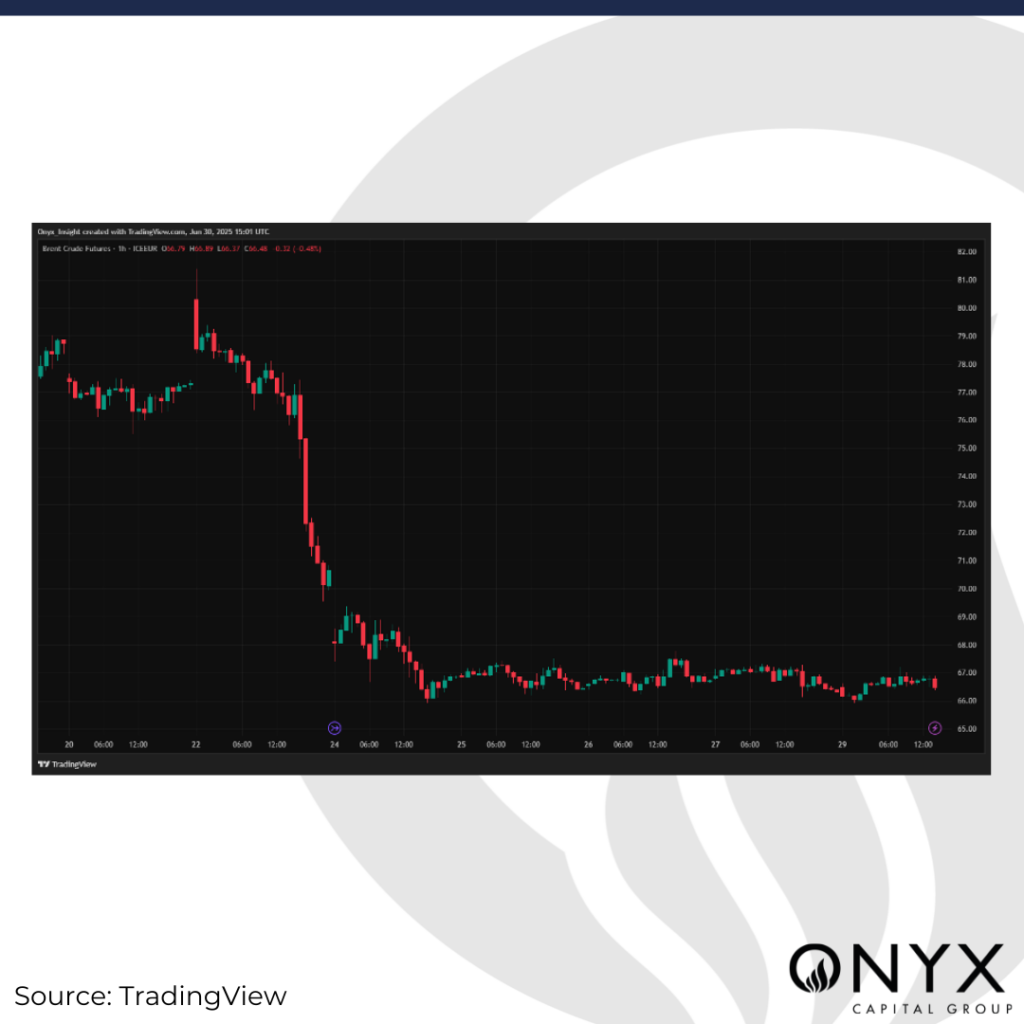Brent crude futures prices have steadied after last week’s sell-off, with market sentiment more balanced. Sep’25 averaged $67/bbl and traded within a $2 range from $66 to $68/bbl over the week. Prices fell sharply following Iran’s retaliation, which involved striking a U.S. air base in Qatar. The threat of disruption to oil flows did not materialise, which quickly deflated the geopolitical risk premium. As the market awaits a new catalyst to drive price action, we expect Sep’25 Brent to tick lower by the end of the week to $63-66/bbl. The following factors inform our cautiously bearish view this week:
- Market Positioning
- OPEC+ Production
- Macroeconomic Sentiment in the US and China

OPEC+ is considering extending its production increases in August at their next meeting on 6 July (this Sunday). Market consensus suggests this would be the fourth consecutive monthly increase by 411kb/d. The decision is consistent with OPEC’s strategy to regain market share quickly. Since actual production from some producers is already above quota, the output hikes largely formalise existing overproduction. Given the optics of another supply hike, any deviation above the expected 411kb/d figure ahead of the weekend could trigger a bearish reaction in outright crude prices.
Market positioning indicates an unwinding of length from speculators as the geopolitical risk premium deflated. However, some length remains from participants who entered on expectations of supply disruptions stemming from the Iran-Israel conflict. ICE COT data for the week ending 24 June show a decline in net length, though bullish positions remain elevated compared to pre-escalation levels. CTA net positions have also flipped short, but are still well above early June levels. Sell-side producer hedging flows have largely subsided following the sell-off. However, downside pressure may persist as players liquidate their war risk length. This comes as the ceasefire between Iran and Israel has held up, while Trump gave explicit approval (via Truth Social) for China to continue buying oil from Iran, suggesting that supply concerns are in the rearview mirror for now. This shifts the market’s focus towards demand, bringing macroeconomic factors into sharper focus.
There is a growing expectation of faster and deeper rate cuts from the Fed as U.S. interest rate futures are pricing in more cuts by the end of 2026. Given consumer spending concerns, economic headwinds may be emerging as a greater concern than inflation. Last week, expectations of sooner rate cuts saw optimism return to U.S. equities, pushing the S&P 500 and Nasdaq to record highs. With Trump being highly critical of Powell, his replacement as Fed Chair could be more dovish. Nonetheless, Powell has signalled a cautious stance on rate cuts, warning that tariff-driven inflation could prove more persistent than expected and needs to be carefully managed before easing policy. Meanwhile, the Fed’s Bowman joined Waller as the second central banker in calling for a cut at the next meeting in July. A slew of economic data releases this week, including the ISM manufacturing and services PMIs, JOLTs job openings, and the unemployment rate, will be closely watched for signals on the U.S. economy’s health. In particular, the market will closely watch U.S. non-farm payrolls, with a softer print expected. A downside surprise could raise hopes of an earlier rate cut, potentially boosting oil prices through improved demand sentiment.
Although China’s manufacturing activity shrank for a third month in June, the reading of 49.7 narrowly beat expectations of 49.6 and was the softest contraction in the sequence. According to a Reuters poll, the Caixin manufacturing PMI is due on Tuesday, which is expected to improve from 48.3 to 49.0 m/m. Meanwhile, container shipments from China to the US hit a two-year low and are down by around 25% since February. However, China’s commerce ministry said on Friday that it would “review and approve applications for the export of eligible controlled items,” while the U.S. would in turn remove a series of restrictive measures imposed on China – an optimistic sign of easing trade tensions.






